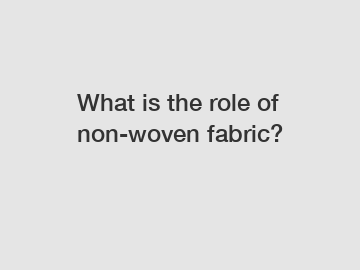What is the role of non-woven fabric?
Non-woven fabric is a versatile material that plays a crucial role in various industries and applications. From medical to automotive, non-woven fabric offers a wide range of benefits and properties that make it an essential component in many products. In this article, we will explore the role of non-woven fabric and how it is used in different sectors.
**Medical Industry**.
Non-woven fabric is widely used in the medical industry due to its excellent barrier properties and breathability. It is often used in surgical masks, gowns, and drapes to protect healthcare workers and patients from pathogens and contaminants. The non-woven fabric used in medical applications is typically made from polypropylene, which is a strong and durable material that can withstand repeated sterilization processes. Additionally, non-woven fabric is lightweight and comfortable to wear, making it ideal for use in medical garments.

**Hygiene Products**.
Non-woven fabric is also commonly used in hygiene products such as baby diapers, feminine hygiene products, and wet wipes. The soft and absorbent nature of non-woven fabric makes it an excellent choice for these applications. Non-woven fabric is also breathable, which helps to keep the skin dry and comfortable. In addition, non-woven fabric can be made with antibacterial or antimicrobial properties to help prevent the growth of harmful bacteria.
**Automotive Industry**.
In the automotive industry, non-woven fabric is used in various components such as headliners, carpets, and upholstery. Non-woven fabric offers excellent acoustic and thermal insulation properties, making it ideal for use in vehicle interiors. It is also lightweight and durable, which helps to reduce the overall weight of the vehicle and improve fuel efficiency. Non-woven fabric is also resistant to mold, mildew, and stains, making it easy to maintain and clean.
**Construction Industry**.
Non-woven fabric is used in the construction industry for a wide range of applications, including geotextiles, roofing membranes, and landscaping fabrics. Non-woven geotextiles are commonly used for soil stabilization, erosion control, and drainage systems. These fabrics help to improve the strength and stability of the soil, reduce erosion, and promote plant growth. Non-woven roofing membranes are used to waterproof and protect buildings from the elements. They are lightweight, flexible, and easy to install, making them an ideal choice for roofing applications.
**Conclusion**.
Non-woven fabric plays a critical role in a wide range of industries and applications, from medical to automotive and construction. Its unique properties such as breathability, absorbency, durability, and insulation make it a versatile and essential material in many products. Whether it is used in surgical masks, hygiene products, vehicle interiors, or construction projects, non-woven fabric offers numerous benefits that enhance the performance and functionality of the end products.
In conclusion, the role of non-woven fabric is undeniable, and its significance continues to grow as new applications and technologies emerge. If you would like to learn more about how non-woven fabric can benefit your industry or product, please contact us.
The company is the world’s best different types of protective coverall, surgical drape TPE film, disposable surgical universal pack supplier. We are your one-stop shop for all needs. Our staff are highly-specialized and will help you find the product you need.

Comments
0